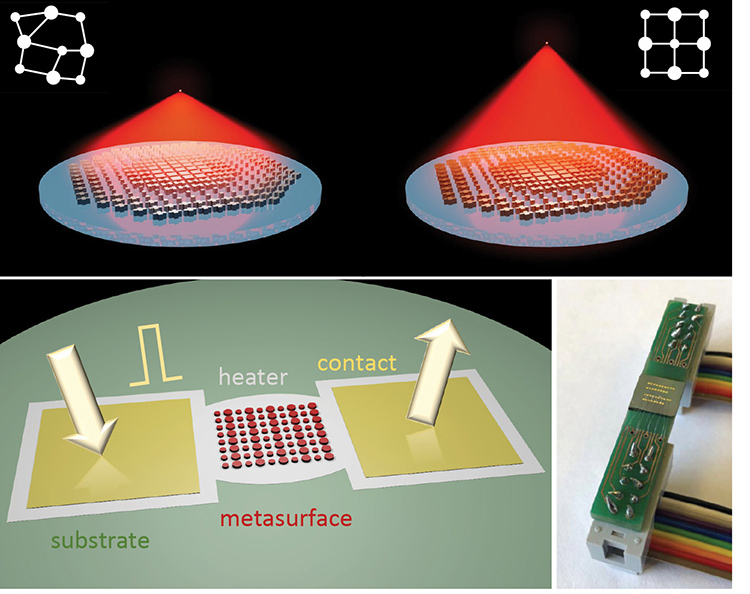 Top: Rendering of a Ge2Sb2Se4Te1 varifocal metalens. The focal-spot position is shifted by changing the crystallinity of the phase-change-material meta-atoms collectively. Bottom: Illustration of an on-chip, electrically switchable metasurface with beam-steering functionality, and photograph of a metasurface chip wire-bonded onto a custom-made printed circuit board.
Top: Rendering of a Ge2Sb2Se4Te1 varifocal metalens. The focal-spot position is shifted by changing the crystallinity of the phase-change-material meta-atoms collectively. Bottom: Illustration of an on-chip, electrically switchable metasurface with beam-steering functionality, and photograph of a metasurface chip wire-bonded onto a custom-made printed circuit board.
Recent progress in nanophotonics has enabled planar optical systems, termed metasurfaces, that hold potential to enable agile light manipulation and provide size, weight, power and cost (SWaP-C) benefits compared with traditional optics. Active metasurfaces, the optical properties of which can be modulated post-fabrication, have attracted a surge of interest in recent years, given their broad potential applications in imaging, sensing, display and optical ranging. A cohort of non-mechanically switchable meta-devices has been already demonstrated; however, most of them either operate within a limited tuning range or suffer from large optical losses.
Our team has developed a novel approach for implementing high-performance reconfigurable metasurfaces made of optical phase-change materials. More specifically, we have synthesized a new class of nonvolatile chalcogenide alloys, Ge2Sb2Se4Te1, exhibiting giant index contrast as well as broadband transparency in both amorphous and crystalline states.1
Capitalizing on this material platform and metasurface design innovation, we demonstrated an all-dielectric varifocal metalens in mid-infrared.2 By annealing the entire metasurface, we showed that the lens shifted its focal plane between the distances of 1.5 mm and 2 mm and produced multi-depth imaging with diffraction-limited resolution and a record-high switching contrast ratio of 30 dB.
This year also witnessed an important milestone in this field: The first demonstrations of electrically switched phase-change metasurfaces. Our group and a team from Stanford University, USA, independent from each other, implemented phase-change-material metasurfaces integrated with electrical micro-heaters.3,4 We showed reversible switching of a tunable metasurface and produced a record half-octave spectral shift with a large relative optical contrast exceeding 400%. By exploiting the same device architecture, we also prototyped a polarization-insensitive deflector for beam steering.
Our advances in phase-change-material meta-optics demonstrate that active metasurfaces can achieve optical quality on par with conventional precision bulk optics involving mechanical moving parts. The work points to exciting applications fully unleashing the SWaP-C benefits of active-metasurface optics.
Note: The authors have posted a video related to this work at www.youtube.com/watch?v=Am5-0zfLgY8.
Researchers
Mikhail Shalaginov, Juejun Hu, Tian Gu, Sensong An, Fan Yang and Yifei Zhang, Massachusetts Institute of Technology, Cambridge, MA, USA
Clayton M. Fowler and Hualiang Zhang, University of Massachusetts, Lowell, MA, USA
References
1. Y. Zhang et al. Nat. Commun. 10, 4279 (2019).
2. M.Y. Shalaginov et al. Nat. Commun. 12, 1225 (2021).
3. Y. Zhang et al. Nat. Nanotechnol. 16, 661 (2021).
4. Y. Wang et al. Nat. Nanotechnol. 16, 667 (2021).

